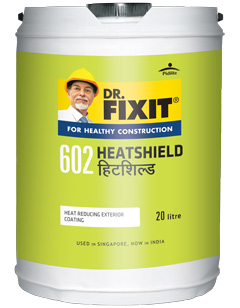Dr. Fixit’s Heatshield

With the rise in temperature during summers, there is a need for a product which helps in reducing internal temperature. A heat-reducing terrace coating that is sure to bring down the temperature by 4-6 degrees C makes your interiors cooler. Dr. Fixit Heatshield has exceptional qualities of saving energy, heat insulation, solar reflectance, UV, IR and Microbial resistance along with being non toxic in nature. It is an ideal product suited for all residential and corporate projects that face extreme climates.
Dr Fixit's Heatshield acts as a heat insulating & waterproof coating on building rooftops & exterior walls because it helps in reducing power consumption substantially by reducing the load on air-conditioners & keeping the interiors cool with an additional function of waterproofing.
Dr. Fixit's Heatshield has the ability to slow down heat transfer remarkably and keeps interiors of externally coated surface of a building cooler by transmitting most of the solar heat back into the atmosphere.

He further adds, "The product will be useful for residential, commercial and industrial projects during the summer and monsoon. We will continue our endeavor to innovate and offer products that are beneficial for both the consumer as well as the environment."
NBM&CW July 2015


















